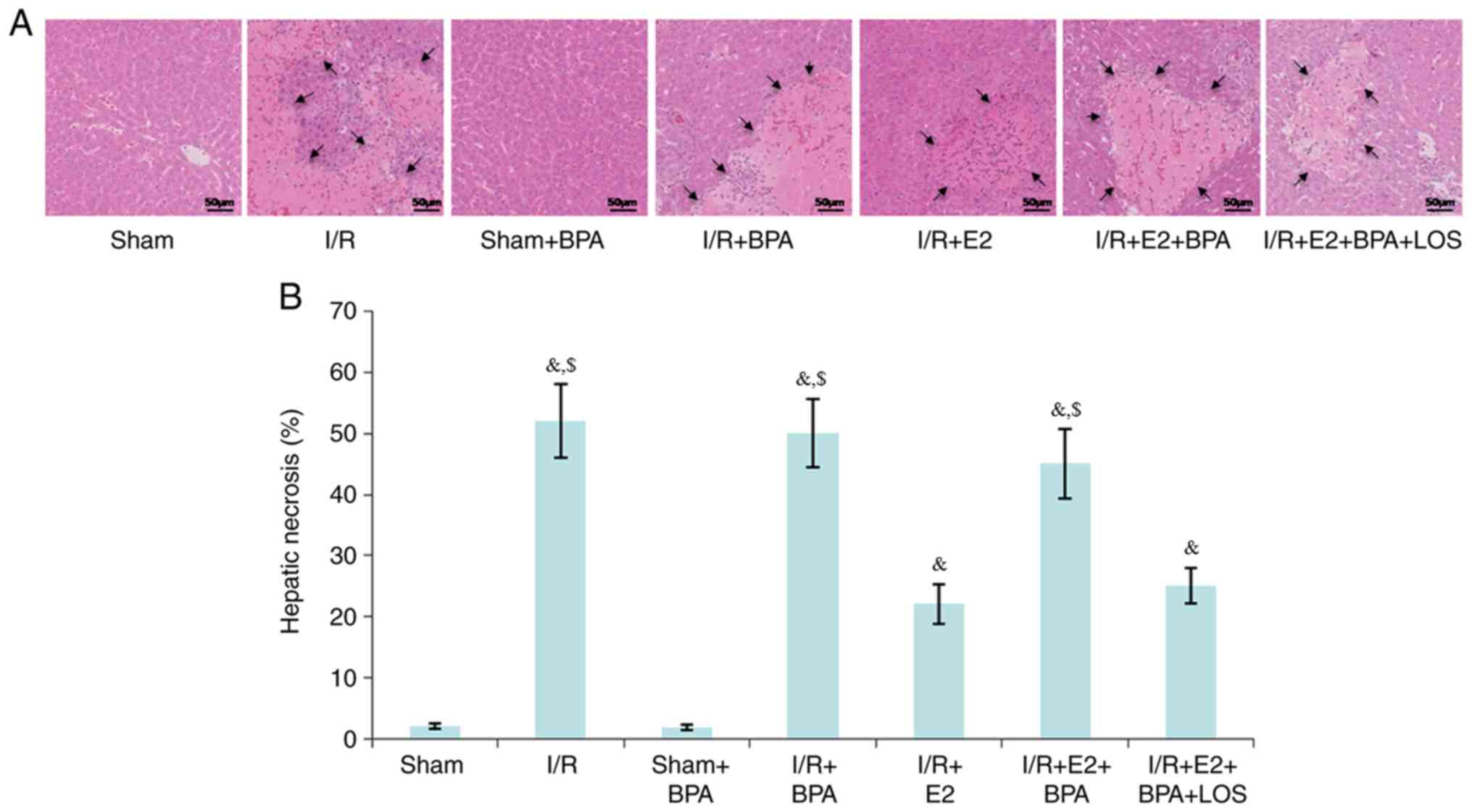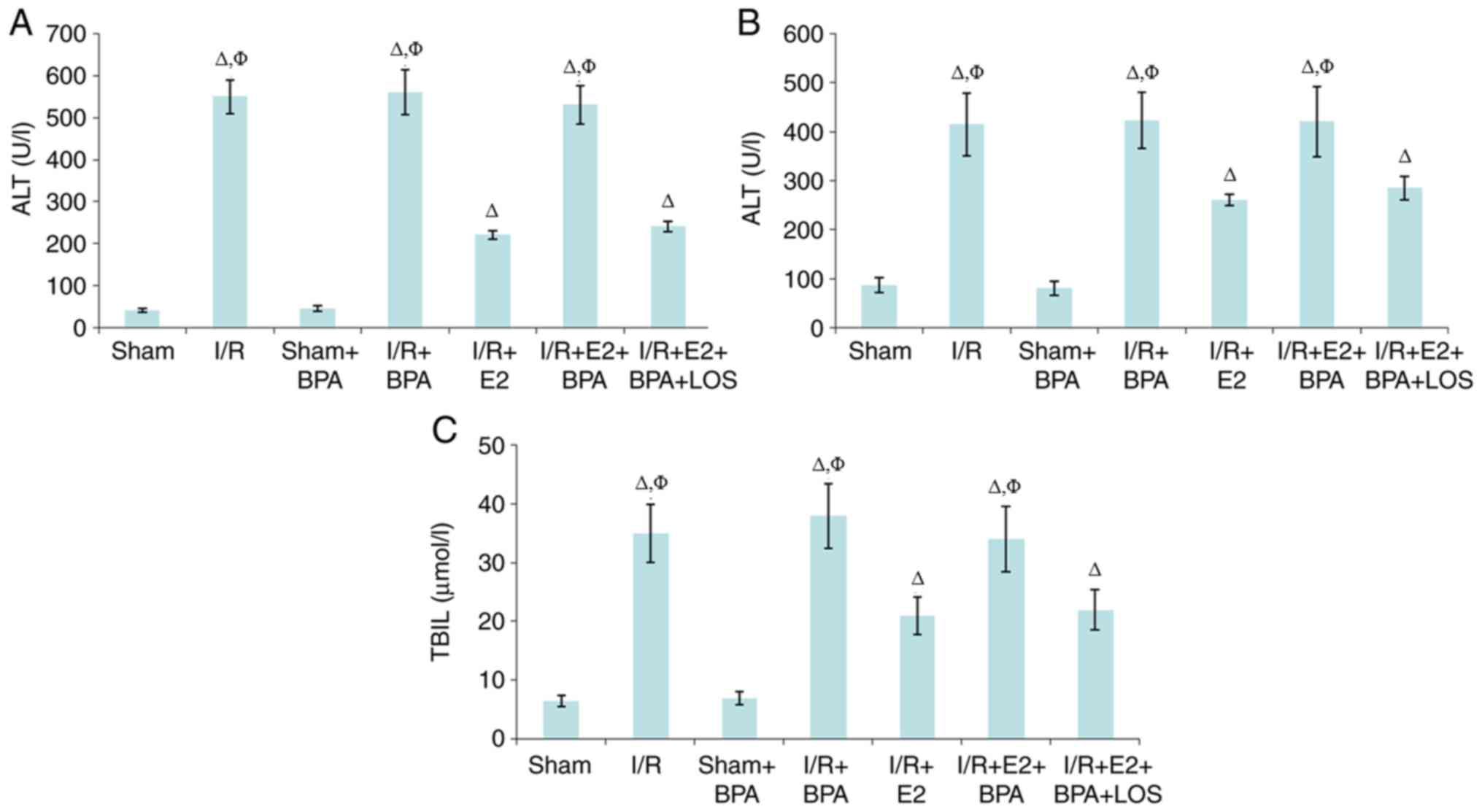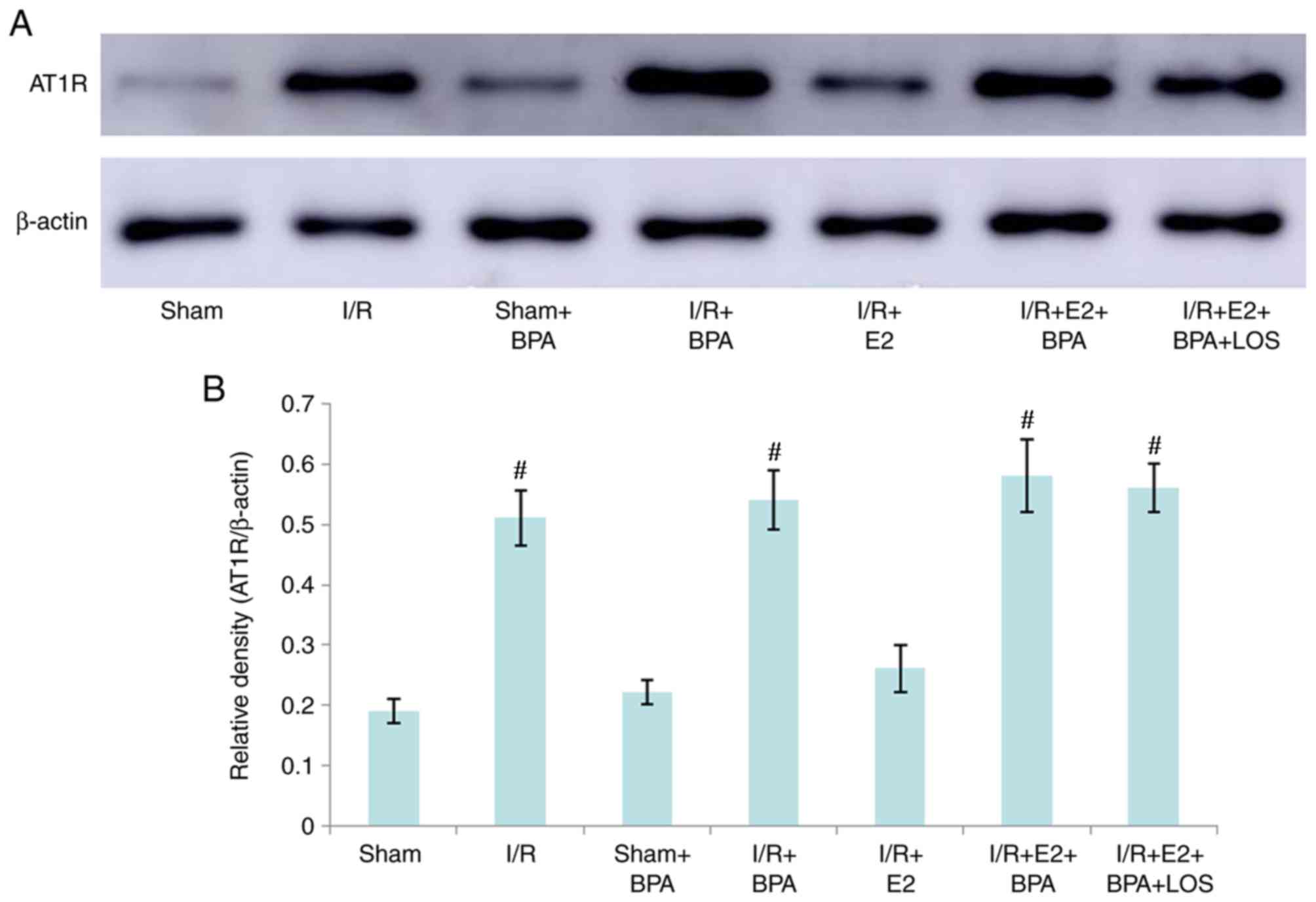|
1
|
Ehrlich S, Calafat AM, Humblet O, Smith T
and Hauser R: Handling of thermal receipts as a source of exposure
to bisphenol A. JAMA. 311:859–860. 2014. View Article : Google Scholar : PubMed/NCBI
|
|
2
|
Fernández M, Bianchi M, Lux-Lantos V and
Libertun C: Neonatal exposure to bisphenol a alters reproductive
parameters and gonadotropin releasing hormone signaling in female
rats. Environ Health Perspect. 117:757–762. 2009. View Article : Google Scholar : PubMed/NCBI
|
|
3
|
Li DK, Zhou Z, Miao M, He Y, Wang J,
Ferber J, Herrinton LJ, Gao E and Yuan W: Urine bisphenol-A (BPA)
level in relation to semen quality. Fertil Steril.
95:625–630.e1-e4. 2011. View Article : Google Scholar : PubMed/NCBI
|
|
4
|
Mahalingam S, Ther L, Gao L, Wang W,
Ziv-Gal A and Flaws JA: The effects of in utero bisphenol A
exposure on ovarian follicle numbers and steroidogenesis in the F1
and F2 generations of mice. Reprod Toxicol. 74:150–157. 2017.
View Article : Google Scholar : PubMed/NCBI
|
|
5
|
Kim D, Yoo ER, Li AA, Cholankeril G, Tighe
SP, Kim W, Harrison SA and Ahmed A: Elevated urinary bisphenol A
levels are associated with non-alcoholic fatty liver disease among
adults in the United States. Liver Int. 39:1335–1342. 2019.
View Article : Google Scholar : PubMed/NCBI
|
|
6
|
Eweda SM, Newairy AS, Abdou HM and Gaber
AS: Bisphenol A-induced oxidative damage in the hepatic and cardiac
tissues of rats: The modulatory role of sesame lignans. Exp Ther
Med. 19:33–44. 2020.PubMed/NCBI
|
|
7
|
Lin R, Jia Y, Wu F, Meng Y, Sun Q and Jia
L: Combined exposure to fructose and bisphenol a exacerbates
abnormal lipid metabolism in liver of developmental male rats. Int
J Environ Res Public Health. 16:E41522019. View Article : Google Scholar : PubMed/NCBI
|
|
8
|
Peerapanyasut W, Kobroob A, Palee S,
Chattipakorn N and Wongmekiat O: N-Acetylcysteine attenuates the
increasing severity of distant organ liver dysfunction after acute
kidney injury in rats exposed to bisphenol a. Antioxidants (Basel).
8:E4972019. View Article : Google Scholar : PubMed/NCBI
|
|
9
|
Peerapanyasut W, Kobroob A, Palee S,
Chattipakorn N and Wongmekiat O: Activation of sirtuin 3 and
maintenance of mitochondrial integrity by N-acetylcysteine protects
against bisphenol A-induced kidney and liver toxicity in rats. Int
J Mol Sci. 20:E2672019. View Article : Google Scholar : PubMed/NCBI
|
|
10
|
Liao X, Zhou S, Zong J and Wang Z:
Sevoflurane exerts protective effects on liver ischemia/reperfusion
injury by regulating NFKB3 expression via miR-9-5p. Exp Ther Med.
17:2632–2640. 2019.PubMed/NCBI
|
|
11
|
Song H, Du C, Wang X, Zhang J and Shen Z:
[Erratum] MicroRNA-101 inhibits autophagy to alleviate liver
ischemia/reperfusion injury via regulating the mTOR signaling
pathway. Int J Mol Med. 43:25322019.PubMed/NCBI
|
|
12
|
Burkhardt M, Slotta JE, Garcia P, Seekamp
A, Menger MD and Pohlemann T: The effect of estrogen on hepatic
microcirculation after ischemia/reperfusion. Int J Colorectal Dis.
23:113–119. 2008. View Article : Google Scholar : PubMed/NCBI
|
|
13
|
Lü P, Liu F, Wang CY, Chen DD, Yao Z, Tian
Y, Zhang JH and Wu YH: Gender differences in hepatic ischemic
reperfusion injury in rats are associated with endothelial cell
nitric oxide synthase-derived nitric oxide. World J Gastroenterol.
11:3441–3445. 2005. View Article : Google Scholar : PubMed/NCBI
|
|
14
|
Yokoyama Y, Kuebler JF, Matsutani T,
Schwacha MG, Bland KI and Chaudry IH: Mechanism of the salutary
effects of 17beta-estradiol following trauma-hemorrhage: Direct
downregulation of Kupffer cell proinflammatory cytokine production.
Cytokine. 21:91–97. 2003. View Article : Google Scholar : PubMed/NCBI
|
|
15
|
Li W, Li D, Sun L, Li Z, Yu L and Wu S:
The protective effects of estrogen on hepatic ischemia-reperfusion
injury in rats by downregulating the Ang II/AT1R pathway. Biochem
Biophys Res Commun. 503:2543–2548. 2018. View Article : Google Scholar : PubMed/NCBI
|
|
16
|
Viñas R and Watson CS: Mixtures of
xenoestrogens disrupt estradiol-induced non-genomic signaling and
downstream functions in pituitary cells. Environ Health. 12:262013.
View Article : Google Scholar : PubMed/NCBI
|
|
17
|
Desdoits-Lethimonier C, Lesné L,
Gaudriault P, Zalko D, Antignac JP, Deceuninck Y, Platel C,
Dejucq-Rainsford N, Mazaud-Guittot S and Jégou B: Parallel
assessment of the effects of bisphenol A and several of its analogs
on the adult human testis. Hum Reprod. 32:1465–1473. 2017.
View Article : Google Scholar : PubMed/NCBI
|
|
18
|
Uzunhisarcikli M and Aslanturk A:
Hepatoprotective effects of curcumin and taurine against bisphenol
A-induced liver injury in rats. Environ Sci Pollut Res Int.
26:37242–37253. 2019. View Article : Google Scholar : PubMed/NCBI
|
|
19
|
Mendes-Braz M, Elias-Miró M,
Jiménez-Castro MB, Casillas-Ramírez A, Ramalho FS and Peralta C:
The current state of knowledge of hepatic ischemia-reperfusion
injury based on its study in experimental models. J Biomed
Biotechnol. 2012:2986572012. View Article : Google Scholar : PubMed/NCBI
|
|
20
|
Wei X, Zheng W, Yang Z, Liu H, Tang T, Li
X and Liu X: Effect of the intermittent Pringle maneuver on liver
damage after hepatectomy: A retrospective cohort study. World J
Surg Oncol. 17:1422019. View Article : Google Scholar : PubMed/NCBI
|
|
21
|
Lin FS, Shen SQ, Chen ZB and Yan RC:
17β-estradiol attenuates reduced-size hepatic ischemia/reperfusion
injury by inhibition apoptosis via mitochondrial pathway in rats.
Shock. 37:183–190. 2012. View Article : Google Scholar : PubMed/NCBI
|
|
22
|
Nilsson EE, Sadler-Riggleman I and Skinner
MK: Environmentally induced epigenetic transgenerational
inheritance of disease. Environ Epigenet. 4:dvy0162018. View Article : Google Scholar : PubMed/NCBI
|
|
23
|
Azushima K, Morisawa N, Tamura K and
Nishiyama A: Recent research advances in
renin-angiotensin-aldosterone system receptors. Curr Hypertens Rep.
22:222020. View Article : Google Scholar : PubMed/NCBI
|
|
24
|
Feng P, Wu Z, Liu H, Shen Y, Yao X, Li X
and Shen Z: Electroacupuncture improved chronic cerebral
hypoperfusion-induced anxiety-like behavior and memory impairments
in spontaneously hypertensive rats by downregulating the ACE/Ang
II/AT1RAxis and upregulating the ACE2/Ang-(1–7)/MasR axis. Neural
Plast. 2020:90760422020. View Article : Google Scholar : PubMed/NCBI
|
|
25
|
Kawabe Y, Mori J, Morimoto H, Yamaguchi M,
Miyagaki S, Ota T, Tsuma Y, Fukuhara S, Nakajima H, Oudit GY and
Hosoi H: ACE2 exerts anti-obesity effect via stimulating brown
adipose tissue and induction of browning in white adipose tissue.
Am J Physiol Endocrinol Metab. 317:E1140–E1149. 2019. View Article : Google Scholar : PubMed/NCBI
|
|
26
|
Figueiredo VP, Barbosa MA, de Castro UGM,
Zacarias AC, Bezerra FS, de Sá RG, de Lima WG, Dos Santos RAS and
Alzamora AC: Antioxidant effects of oral Ang-(1–7) restore insulin
pathway and RAS components ameliorating cardiometabolic
disturbances in rats. Oxid Med Cell Longev. 2019:58689352019.
View Article : Google Scholar : PubMed/NCBI
|
|
27
|
Wang D, Chai XQ, Magnussen CG, Zosky GR,
Shu SH, Wei X and Hu SS: Renin-angiotensin-system, a potential
pharmacological candidate, in acute respiratory distress syndrome
during mechanical ventilation. Pulm Pharmacol Ther. 58:1018332019.
View Article : Google Scholar : PubMed/NCBI
|
|
28
|
Chen Z, Li T, Zhang L, Wang H and Hu F:
Bisphenol A exposure remodels cognition of male rats attributable
to excitatory alterations in the hippocampus and visual cortex.
Toxicology. 410:132–141. 2018. View Article : Google Scholar : PubMed/NCBI
|
|
29
|
Negishi T, Kawasaki K, Takatori A, Ishii
Y, Kyuwa S, Kuroda Y and Yoshikawa Y: Effects of perinatal exposure
to bisphenol A on the behavior of offspring in F344 rats. Environ
Toxicol Pharmacol. 14:99–108. 2003. View Article : Google Scholar : PubMed/NCBI
|
|
30
|
Korkmaz A, Ahbab MA, Kolankaya D and
Barlas N: Influence of vitamin C on bisphenol A, nonylphenol and
octylphenol induced oxidative damages in liver of male rats. Food
Chem Toxicol. 48:2865–2871. 2010. View Article : Google Scholar : PubMed/NCBI
|
|
31
|
Kazemi S, Mousavi SN, Aghapour F, Rezaee
B, Sadeghi F and Moghadamnia AA: Induction effect of bisphenol A on
gene expression involving hepatic oxidative stress in rat. Oxid Med
Cell Longev. 2016:62985152016. View Article : Google Scholar : PubMed/NCBI
|
|
32
|
Guo Y, Hu B, Huang H, Tsung A, Gaikwad NW,
Xu M, Jiang M, Ren S, Fan J, Billiar TR, et al: Estrogen
sulfotransferase is an oxidative stress-responsive gene that
gender-specifically affects liver ischemia/reperfusion injury. J
Biol Chem. 290:14754–14764. 2015. View Article : Google Scholar : PubMed/NCBI
|
|
33
|
de Vries HA, Ponds FA, Nieuwenhuijs VB,
Morphett A, Padbury RT and Barritt GJ: Evidence that estrogen
receptors play a limited role in mediating enhanced recovery of
bile flow in female rats in the acute phase of liver ischemia
reperfusion injury. Ann Hepatol. 12:130–137. 2013. View Article : Google Scholar : PubMed/NCBI
|
|
34
|
Yang X, Qin L, Liu J, Tian L and Qian H:
17β-Estradiol protects the liver against cold ischemia/reperfusion
injury through the Akt kinase pathway. J Surg Res. 178:996–1002.
2012. View Article : Google Scholar : PubMed/NCBI
|
|
35
|
Eckhoff DE, Bilbao G, Frenette L, Thompson
JA and Contreras JL: 17-Beta-estradiol protects the liver against
warm ischemia/reperfusion injury and is associated with increased
serum nitric oxide and decreased tumor necrosis factor-alpha.
Surgery. 132:302–309. 2002. View Article : Google Scholar : PubMed/NCBI
|
|
36
|
Shen SQ, Zhang Y and Xiong CL: The
protective effects of 17beta-estradiol on hepatic
ischemia-reperfusion injury in rat model, associated with
regulation of heat-shock protein expression. J Surg Res. 140:67–76.
2007. View Article : Google Scholar : PubMed/NCBI
|
|
37
|
Vilatoba M, Eckstein C, Bilbao G, Frennete
L, Eckhoff DE and Contreras JL: 17beta-estradiol differentially
activates mitogen-activated protein-kinases and improves survival
following reperfusion injury of reduced-size liver in mice.
Transplant Proc. 37:399–403. 2005. View Article : Google Scholar : PubMed/NCBI
|
|
38
|
Ng IO, Ng M and Fan ST: Better survival in
women with resected hepatocellular carcinoma is not related to
tumor proliferation or expression of hormone receptors. Am J
Gastroenterol. 92:1355–1358. 1997.PubMed/NCBI
|
|
39
|
Yokoyama Y, Nagino M and Nimura Y: Which
gender is better positioned in the process of liver surgery? Male
or female? Surg Today. 37:823–830. 2007. View Article : Google Scholar : PubMed/NCBI
|
|
40
|
Konieczna A, Rutkowska A and Rachoń D:
Health risk of exposure to Bisphenol A (BPA). Rocz Panstw Zakl Hig.
66:5–11. 2015.PubMed/NCBI
|
|
41
|
Mehta PK and Griendling KK: Angiotensin II
cell signaling: Physiological and pathological effects in the
cardiovascular system. Am J Physiol Cell Physiol. 292:C82–C97.
2007. View Article : Google Scholar : PubMed/NCBI
|
|
42
|
Pueyo ME, Gonzalez W, Nicoletti A, Savoie
F, Arnal JF and Michel JB: Angiotensin II stimulates endothelial
vascular cell adhesion molecule-1 via nuclear factor-kappaB
activation induced by intracellular oxidative stress. Arterioscler
Thromb Vasc Biol. 20:645–651. 2000. View Article : Google Scholar : PubMed/NCBI
|
|
43
|
Yusof M, Kamada K, Gaskin FS and Korthuis
RJ: Angiotensin II mediates postischemic leukocyte-endothelial
interactions: Role of calcitonin gene-related peptide. Am J Physiol
Heart Circ Physiol. 292:H3032–H3037. 2007. View Article : Google Scholar : PubMed/NCBI
|
|
44
|
Ruiz-Ortega M, Lorenzo O, Rupérez M,
Blanco J and Egido J: Systemic infusion of angiotensin II into
normal rats activates nuclear factor-kappaB and AP-1 in the kidney:
Role of AT(1) and AT(2) receptors. Am J Pathol. 158:1743–1756.
2001. View Article : Google Scholar : PubMed/NCBI
|
|
45
|
Harrison DG, Cai H, Landmesser U and
Griendling KK: Interactions of angiotensin II with NAD(P)H oxidase,
oxidant stress and cardiovascular disease. J Renin Angiotensin
Aldosterone Syst. 4:51–61. 2003. View Article : Google Scholar : PubMed/NCBI
|
|
46
|
Li X, Cai W, Xi W, Sun W, Shen W, Wei T,
Chen X, Sun L, Zhou H, Sun Y, et al: MicroRNA-31 Regulates
immunosuppression in Ang II (Angiotensin II)-induced hypertension
by targeting Ppp6C (Protein Phosphatase 6c). Hypertension.
73:e14–e24. 2019. View Article : Google Scholar : PubMed/NCBI
|
|
47
|
Alfany-Fernandez I, Casillas-Ramirez A,
Bintanel-Morcillo M, Brosnihan KB, Ferrario CM, Serafin A, Rimola
A, Rodés J, Roselló-Catafau J and Peralta C: Therapeutic targets in
liver transplantation: Angiotensin II in nonsteatotic grafts and
angiotensin-(1–7) in steatotic grafts. Am J Transplant. 9:439–451.
2009. View Article : Google Scholar : PubMed/NCBI
|
|
48
|
Sabry MM, Ramadan NM, Al Dreny BA, Rashed
LA and Abo El Enein A: Protective effect of apelin preconditioning
in a rat model of hepatic ischemia reperfusion injury; possible
interaction between the apelin/APJ system, Ang II/AT1R system and
eNOS. United European Gastroenterol J. 7:689–698. 2019. View Article : Google Scholar : PubMed/NCBI
|
|
49
|
Saura M, Marquez S, Reventun P,
Olea-Herrero N, Arenas MI, Moreno-Gómez-Toledano R, Gómez-Parrizas
M, Muñóz-Moreno C, González-Santander M, Zaragoza C and Bosch RJ:
Oral administration of bisphenol A induces high blood pressure
through angiotensin II/CaMKII-dependent uncoupling of eNOS. FASEB
J. 28:4719–4728. 2014. View Article : Google Scholar : PubMed/NCBI
|
|
50
|
Gao F, Huang Y, Zhang L and Liu W:
Involvement of estrogen receptor and GPER in bisphenol A induced
proliferation of vascular smooth muscle cells. Toxicol In Vitro.
56:156–162. 2019. View Article : Google Scholar : PubMed/NCBI
|
|
51
|
Abbasloo E, Najafipour H and Vakili A:
Chronic treatment with apelin, losartan and their combination
reduces myocardial infarct size and improves cardiac mechanical
function. Clin Exp Pharmacol Physiol. 47:393–402. 2019. View Article : Google Scholar : PubMed/NCBI
|
|
52
|
Panico K, Abrahão MV, Trentin-Sonoda M,
Muzi-Filho H, Vieyra A and Carneiro-Ramos MS: Cardiac inflammation
after ischemia-reperfusion of the kidney: Role of the sympathetic
nervous system and the renin-angiotensin system. Cell Physiol
Biochem. 53:587–605. 2019. View Article : Google Scholar : PubMed/NCBI
|


















